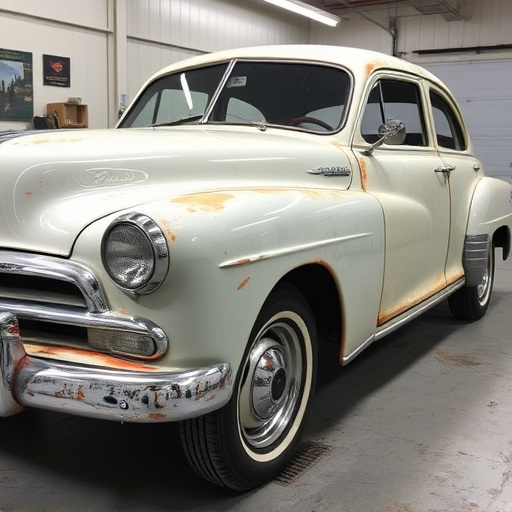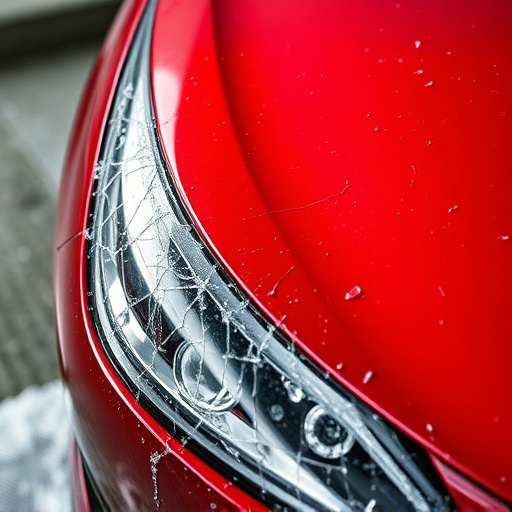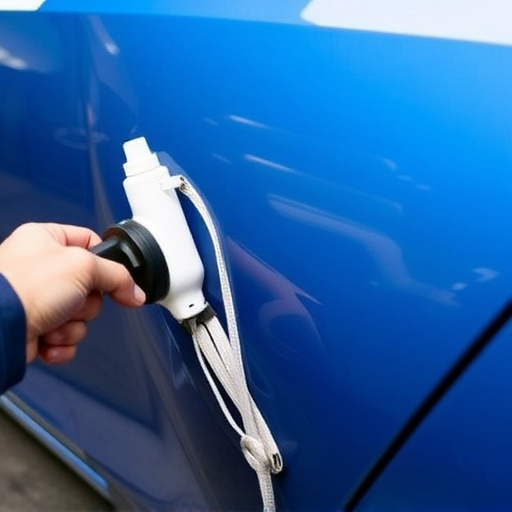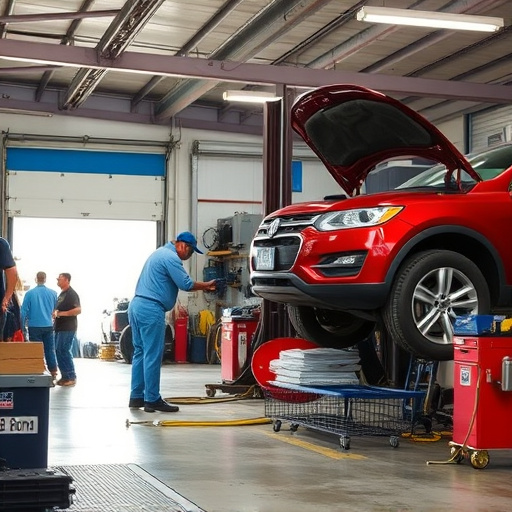Mastering Tesla Black Paint Restoration: Step-by-Step Guide to Perfection

Tesla black paint restoration involves a meticulous process: visual inspection, repair technique sel…….
In the realm of automotive aesthetics, ‘Tesla Black Paint Restoration’ has emerged as a specialized art, combining precision craftsmanship with cutting-edge technology. This process involves revitalizing the iconic black paintwork on Tesla vehicles, ensuring they maintain their sleek and modern appearance. As electric vehicle (EV) ownership soars globally, understanding this restoration technique is more crucial than ever. This article delves into the intricate world of Tesla black paint restoration, exploring its historical roots, global impact, technological innovations, and future prospects. By the end, readers will grasp the significance of this process in the broader context of automotive care and preservation.
Definition: Tesla black paint restoration is a meticulous process aimed at rejuvenating the jet-black exterior paint on Tesla vehicles, restoring their original luster and depth. It involves multiple steps, from surface preparation to advanced coating techniques, ensuring the paintwork not only looks new but also provides superior protection against environmental factors.
Core Components:
Surface Preparation: This initial phase includes thorough cleaning, de-greasing, and sanding of the car’s exterior to ensure a smooth base for painting. It involves removing any contaminants, scratches, or old coatings.
Coating Application: Skilled technicians use high-quality, specialized black paint designed to meet Tesla’s strict standards. This is applied in thin, even layers, allowing for precise control over the final finish. Modern techniques often include airless spraying and advanced electrostatic painting for optimal coverage and efficiency.
Curing and Hardening: After application, the paint undergoes a controlled curing process, ensuring it achieves maximum hardness and durability. This step is crucial for achieving a long-lasting, scratch-resistant finish.
Quality Inspection: Final inspection ensures the restored paintwork meets Tesla’s quality standards and provides a flawless appearance.
Historical Context: Since the introduction of Tesla vehicles, their distinctive black paint finishes have become iconic. As these cars age, proper restoration becomes essential to preserve their aesthetic appeal. Over time, advanced coating technologies and environmental considerations have shaped the methods used in this process.
Tesla black paint restoration has left an indelible mark on the global automotive industry, influencing not just Tesla owners but also enthusiasts and professionals worldwide. Here’s a glimpse into its international impact:
North America: The United States and Canada have seen a surge in demand for Tesla vehicle ownership, leading to a corresponding increase in restoration services. Many specialized shops cater specifically to Tesla owners, offering top-tier restoration techniques.
Europe: With a significant market share in Europe, Tesla has inspired a dedicated following of restorers and enthusiasts. Countries like Germany and the UK have become hubs for advanced paint technology research, contributing to global standards.
Asia-Pacific: China and Japan, with their vast automotive industries, are also influential players. Local manufacturers produce high-quality black paint coatings, meeting the region’s diverse needs.
Key Trends:
Eco-Friendly Coatings: There is a growing trend towards using environmentally friendly coatings that reduce harmful emissions during application and cure faster, minimizing environmental impact.
Advanced Surface Treatments: Restorers are exploring innovative surface treatments, such as ceramic coatings, which offer enhanced protection against scratches, stains, and UV damage.
Custom Finishes: Some restorers are pushing boundaries with custom black variations, incorporating unique pigments and effects to create one-of-a-kind finishes.
The economic landscape surrounding Tesla black paint restoration is dynamic and multifaceted:
The global automotive refinish market, valued at USD 132.4 billion in 2021 (Source: Grand View Research), is expected to grow further with the rise of electric vehicles. Tesla black paint restoration contributes significantly to this sector, especially as Tesla’s popularity surges.
Specialized restoration services for luxury and electric vehicles often command premium prices due to the skill and materials required.
Many professional restorers invest heavily in advanced equipment and training to stay ahead of industry trends. This includes purchasing state-of-the-art spraying systems, sanders, and quality inspection tools.
Some Tesla owners choose to invest in premium restoration services as a long-term protective measure for their vehicles’ resale value.
The restoration industry contributes to economic growth by creating employment opportunities and generating revenue within local communities.
In regions with high Tesla ownership, specialized restoration shops can become key economic players, fostering entrepreneurship and skill development.
Technological innovations have revolutionized Tesla black paint restoration, improving efficiency, quality, and sustainability:
| Advancement | Impact | Future Potential |
|---|---|---|
| Airless Spraying | Reduces overspray, waste, and application time. Provides consistent coating thickness. | Expected to become industry standard due to its efficiency, cost-effectiveness, and environmental benefits. |
| Electrostatic Painting | Enhances paint distribution, ensuring even coverage on complex vehicle surfaces. | Could be combined with airless spraying for even greater precision and speed. |
| Advanced Pigments | Offers enhanced color depth and durability. Some pigments change color under UV light, adding a dynamic element to finishes. | Continuous research aims to create more responsive pigments, expanding design possibilities. |
| Ceramic Coatings | Provides an extra layer of protection against environmental damage, enhancing the overall finish. | Increasingly popular for its durability and ease of maintenance. Expected to be integrated into standard restoration processes. |
| Digital Color Matching | Utilizes advanced software to precisely match paint colors, ensuring perfect color consistency. | AI-driven systems could further refine color matching, offering personalized finishes tailored to individual vehicles. |
The landscape of policies and regulations surrounding Tesla black paint restoration is diverse but crucial in ensuring safety, quality, and environmental compliance:
Emission Standards: Many countries have strict emission standards for automotive coatings, dictating the types of paints and solvents that can be used. Restorers must adhere to these regulations to avoid legal repercussions.
Product Safety: Regulations require restorers to handle and dispose of coating materials safely, minimizing environmental and health risks.
Warranty Considerations: Tesla, like other automakers, provides warranties on their vehicles’ paintwork. Restorers must be aware of these terms to ensure they do not void them.
Regional Guidelines: Different regions have varying guidelines for automotive restoration, particularly in areas with unique environmental concerns or cultural preferences for vehicle aesthetics.
Despite its advancements, Tesla black paint restoration faces several challenges and criticisms:
Skill Shortage: Skilled restorers are in high demand, creating a shortage of qualified professionals to meet the growing need. Training programs and apprenticeship initiatives can help address this issue.
Cost Concerns: Restoration services for electric vehicles, including Tesla, can be expensive due to specialized materials and techniques. Making these services more accessible is crucial for widespread adoption.
Environmental Impact: While efforts have been made to reduce environmental impact, some coatings still contain harmful chemicals. Restorers must stay updated on eco-friendly alternatives.
Proposed Solutions:
Industry Standardization: Establishing clear industry standards and certifications can ensure consistent quality across restoration shops.
Government Incentives: Governments can encourage restorers to adopt eco-friendly practices by offering incentives or subsidies for sustainable coatings and methods.
Community Engagement: Collaborating with local schools and training institutions can help build a skilled workforce while fostering community interest in automotive restoration.
A renowned restorer in California took on the challenge of restoring a 2017 Tesla Model S to its original factory finish. The process involved:
Detailing and Cleaning: Thorough cleaning and de-greasing using specialized chemicals to prepare the surface for painting.
Sanding: Applying 400-grit sandpaper to achieve a smooth base, removing minor scratches and imperfections.
Coating Application: Using an airless spraying system, they applied three thin layers of Tesla’s original black paint, allowing each layer to cure before the next was applied.
Curing and Inspection: The car was left in a controlled environment for 24 hours, then inspected for any defects or inconsistencies.
The final result was a flawless, factory-like finish that commanded attention at various automotive shows. This case study exemplifies the meticulous craftsmanship required in Tesla black paint restoration.
In Germany, a forward-thinking restorer embraced eco-friendly practices by transitioning to water-based coatings for Tesla vehicle restorations. The benefits included:
Reduced Emissions: Water-based coatings have lower VOCs (Volatile Organic Compounds), contributing to improved air quality during the restoration process.
Enhanced Durability: These coatings offer excellent durability, providing long-lasting protection without compromising aesthetics.
Customer Satisfaction: Many Tesla owners in Europe appreciate the environmental benefits, making this approach appealing and marketable.
The future of Tesla black paint restoration is promising, shaped by technological advancements and evolving consumer preferences:
Personalized Finishes: With advanced digital tools, restorers can offer custom finishes, allowing owners to choose unique colors or special effects.
Integration of AI: Artificial intelligence will play a significant role in color matching, predictive maintenance for equipment, and even automated surface preparation.
Sustainable Growth: The industry is expected to continue moving towards eco-friendly solutions, driven by consumer demand and regulatory pressures.
Global Expansion: As Tesla’s market share grows globally, so will the need for specialized restoration services. Restorers who adapt to local preferences and regulations will thrive.
Tesla black paint restoration is a testament to human ingenuity and our relentless pursuit of perfection. It transcends mere vehicle aesthetics, influencing global trends, fostering economic growth, and driving technological advancements. As electric vehicles continue to shape the automotive landscape, the importance of this restoration process will only grow. By embracing innovation, addressing challenges, and prioritizing sustainability, restorers worldwide can ensure that Tesla vehicles maintain their iconic black luster for generations to come.
Q: How often should I get my Tesla’s paint restored?
A: The frequency depends on several factors, including driving conditions, environment, and personal preferences. As a general guideline, consider restoration every 2-3 years or when you notice significant scratches, stains, or loss of gloss.
Q: Are there any DIY methods for Tesla black paint restoration?
A: While some basic surface cleaning and detailing can be done at home, professional restoration is recommended for achieving a flawless finish. Specialized equipment and expertise are required to ensure the paintwork is not damaged during the process.
Q: Can I choose any black paint color for my Tesla restoration?
A: Restorers typically use Tesla’s original factory-specified black paint or closely matching alternatives. While custom colors are possible, they may require additional preparation and could void certain warranties.
Q: How do environmental factors impact Tesla paintwork?
A: Extreme temperatures, UV exposure, and humidity can affect the durability of paintwork. Restorers often take these factors into account when selecting coatings and preparing surfaces to ensure optimal long-term performance.
Q: Are there any new technologies on the horizon for Tesla black paint restoration?
A: Absolutely! Fields like AI and nanotechnology are expected to revolutionize restoration. AI can enhance color matching and predictive maintenance, while nanotechnology could lead to even more durable and responsive coatings.

Tesla black paint restoration involves a meticulous process: visual inspection, repair technique sel…….

Tesla black paint restoration demands advanced knowledge of unique paint composition and specialized…….

Tesla black paint restoration demands specialized care due to its advanced coating. Bird droppings a…….

Tesla black paint restoration demands meticulous preparation: inspecting and buffing the surface for…….

For a successful Tesla black paint restoration, start with thorough surface preparation to eliminate…….

Tesla black paint restoration demands specialized knowledge and techniques due to unique manufacturi…….

Tesla black paint oxidation and fading are common due to environmental factors. Restoration services…….